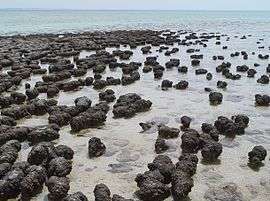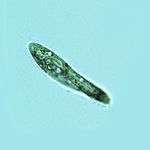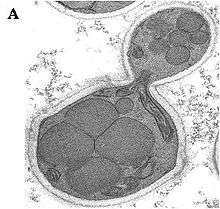Unicellular organism
| Unicellular organism | |
|---|---|
|
Archean–present | |
|
Valonia ventricosa, a species of alga with a diameter that ranges typically from 1 to 4 centimetres (0.39 to 1.57 in) is among the largest unicellular species |
A unicellular organism, also known as a single-celled organism, is an organism that consists of only one cell, unlike a multicellular organism that consists of more than one cell. Historically, the simple single celled organisms have sometimes been referred to as monads,[1] specially the unicellular flagellates. The main groups of unicellular organisms are bacteria, archaea, protozoa, unicellular algae, and unicellular fungi. Unicellular organisms fall into two general categories: prokaryotic organisms and eukaryotic organisms. Unicellular organisms are thought to be the oldest form of life, with early protocells possibly emerging 3.8–4 billion years ago.[2][3]
Prokaryotes, most Protista, and some fungi are unicellular. Although some of these organisms live in colonies, they don't exhibit specialization. These organisms live together, and each cell in the colony is the same. However, each individual cell must carry out all life processes to survive. In contrast, even the simplest multicellular organisms have cells that depend on each other to survive.
Most multicellular organisms have a unicellular life-cycle stage. Gametes, for example, are reproductive unicells for multicellular organisms.[4] Additionally, multicellularity appears to have evolved independently many times in the history of life.
Some organisms are partially uni- and multicellular, like Dictyostelium discoideum. Additionally, unicellular organisms can be multinucleate, like Myxogastria and Plasmodium.
Candidatus Magnetoglobus multicellular, related to Deltaproteobacteria, is a multicellular prokaryote. It is neither unicellular, nor a colony.
Evolutionary hypothesis
Primitive cells, often referred to as protocells, are the precursors to today's unicellular organisms. Although the origin of life is largely still a mystery, in the currently prevailing theory, known as the RNA world hypothesis, early RNA molecules would have been the basis for catalyzing organic chemical reactions and self-replication.[5] The RNA world hypothesis assumes that RNA molecules could form in abiotic conditions, which would require nucleic acids and ribose to be present. Theoretical and experimental findings show that nucleic acids and sugars could have been synthesized in early prebiotic conditions.[5]
Compartmentalization was necessary for chemical reactions to be more likely as well as to differentiate reactions with the external environment. For example, an early RNA replicator ribozyme may have replicated other replicator ribozymes of different RNA sequences if not kept separate.[6]
When amphiphiles like lipids are placed in water, the hydrophobic (water fearing) tails aggregate to form micelles and vesicles, with the hydrophilic (water loving) ends facing outwards.[3][6] Primitive cells likely used self-assembling fatty-acid vesicles to separate chemical reactions and the environment.[6] Because of their simplicity and ability to self-assemble in water, it's likely that these simple membranes predated other forms of early biological molecules.[3]
Prokaryotes
Prokaryotes lack membrane-bound organelles, such as mitochondria or a nucleus.[7] Instead, most prokaryotes have an irregular region that contains DNA, known as the nucleoid.[8] Most prokaryotes have a single, circular chromosome, which is in contrast to eukaryotes, which typically have linear chromosomes.[9] Nutritionally, prokaryotes have the ability to utilize a wide range of organic and inorganic material for use in metabolism, including sulfur, cellulose, ammonia, or nitrite.[10] Prokaryotes as a whole are ubiquitous in the environment and exist in extreme environments as well.
Bacteria

Bacteria are one of the world’s oldest forms of life, and are found virtually everywhere in nature.[10] Many common bacteria have plasmids, which are short, circular, self-replicating DNA molecules that are separate from the bacteria chromosome.[12] Plasmids can carry genes responsible for novel abilities, of current critical importance being antibiotic resistance.[13] Bacteria predominantly reproduce asexually through a process called binary fission, although plasmids can be exchanged through the use of a pilus in a process known as conjugation.[13]
The photosynthetic cyanobacteria are arguably the most successful bacteria, and changed the early atmosphere of the earth by oxygenating it.[14] Stromatolites, structures made up of layers of calcium carbonate and trapped sediment left over from cyanobacteria and associated community bacteria, left behind extensive fossil records.[14][15] The existence of stromatolites gives an excellent record as to the development of cyanobacteria, which are represented across the Archaean (4 billion to 2.5 billion years ago), Proterozoic (2.5 billion to 540 million years ago), and Phanerozoic (540 million years ago to present day) eons.[15] Much of the fossilized stromatolites of the world can be found in Western Australia.[15] There, some of the oldest stromatolites have been found, some dating back to about 3,430 million years ago.[15]
Archaea

Hydrothermal vents release heat and hydrogen sulfide, allowing extremophiles to survive using chemolithotrophic growth.[17] Archaea are generally similar in appearance to bacteria, hence their original classification as bacteria, but have significant molecular differences most notably in their membrane structure and ribosomal RNA.[18][19] By sequencing the ribosomal RNA, it was found that the Archeae most likely split from bacteria and were the precursors to modern eukaryotes, and are actually more phylogenetically related to eukaryotes.[19] As their name suggests, Archeae comes from a Greek word archaios, meaning original, ancient, or primitive.[20]
Some archaea inhabit the most biologically inhospitable environments on earth, and this is believed to in some ways mimic the early, harsh conditions that life was likely exposed to. Examples of these Archaean extremophiles are as follows:
- Thermophiles, optimum growth temperature of 50 °C-110 °C, including the genera Pyrobaculum, Pyrodictium, Pyrococcus and Melanopyrus.[21]
- Psychrophiles, optimum growth temperature of less than 15 °C, including the genera Methanogenium and Halorubrum.[21]
- Alkaliphiles, optimum growth pH of greater than 8, including the genus Natronomonas.[21][22]
- Acidophiles, optimum growth pH of less than 3, including the genera Sulfolobus and Picrophilus.[21][23]
- Piezophiles, (also known as barophiles), prefer high pressure up to 130 MPa, such as deep ocean environments, including the genera Methanococcus and Pyrococcus.[21]
- Halophiles, grow optimally in high salt concentrations between 0.2 M and 5.2 M NaCL, including the genera Haloarcula, Haloferax, Halococcus.[21][24]
Methanogens are a significant subset of archaea and include many extremophiles, but are also ubiquitous in wetland environments as well as the ruminant and hindgut of animals.[25] This process utilizes hydrogen to reduce carbon dioxide into methane, releasing energy into the usable form of adenosine triphosphate.[25] They are the only known organisms capable of producing methane.[26]
Eukaryotes
Eukaryotes are cells that contain membrane bound organelles, such as mitochondria, a nucleus, and chloroplasts. Prokaryotic cells transitioning into eukaryotic cells likely occurred between 2.0–1.4 billion years ago.[27] This was an important step in evolution, which led to multicellularity of some eukaryotes into plants, animals and fungi. In contrast to prokaryotes, eukaryotes reproduce by using mitosis and meiosis. Meiosis, a true sexual process, allows for a greater range of genetic diversity by combining the DNA of the parents followed by recombination.[27] Metabolic functions in eukaryotes are more specialized as well by sectioning specific processes into organelles.
Also important to eukaryotes is the endosymbiotic theory, which points out that mitochondria and chloroplasts likely have bacterial origins. Both organelles contain their own sets of DNA and have bacteria-like ribosomes. It's likely that modern mitochondria were once a species similar to Rickettsia, with the parasitic ability to enter a cell.[28] However, if the bacteria were capable of respiration, it would have been beneficial for the larger cell to allow the parasite to live in return for energy and detoxification of oxygen.[28] Chloroplasts probably became symbiants through a similar set of events, and are most likely descendants of cyanobacteria.[29] While not all eukaryotes have mitochondria or chloroplasts, mitochondria are found in most eukaryotes, and chloroplasts are found in all plants and algae. Photosynthesis and respiration are essentially the reverse of one another, and the advent of respiration coupled with photosynthesis enabled much greater access to energy than fermentation alone.
Protozoa

Protozoa are largely defined by their method of locomotion, including flagella, cilia, and pseudopodia.[30] While there has been considerable debate on the classification of protozoa caused by their sheer diversity, there are currently 7 phyla recognized under the kingdom protozoa: Euglenozoa, Amoebozoa, Choanozoa, Loukozoa, Percolozoa, Microsporidia and Sulcozoa.[31][32] Protozoa, like plants and animals, can be considered heterotrophs or autotrophs.[30] Autotrophs like Euglena are capable of producing their energy using photosynthesis, while heterotrophic protozoa consume food by either funneling it through a mouth-like gullet or engulfing it with pseudopods, a form of phagocytosis.[30] While protozoa reproduce mainly asexually, some protozoa are capable of sexual reproduction.[30]
Ciliophora, or ciliates, are a group of protists that utilize cilia for locomotion. Examples include Paramecia, Stentors, and Vorticella.[33] Ciliates are widely abundant in almost all environments where water can be found, and the cilia beat rhythmically in order to propel the organism.[34] Many ciliates have trichocysts, which are spear-like organelles that can be discharged to catch prey, anchor themselves, or for defense.[35][36] Ciliates are also capable of sexual reproduction, and utilize two nuclei unique to ciliates: a macronucleus for normal metabolic control and a separate micronucleus that undergoes meiosis.[35]
The Amebozoa utilize pseudopodia and cytoplasmic flow to move in their environment. Most Amebas are unicellular, although a few can become multicellular, such as Physarum polycephalum, a slime mold.[37] Entamoeba histolytica is the cause of amebic dysentery.[38]
Unicellular algae

Unicellular algae are plant-like autotrophs and contain chlorophyll.[39] They include groups that have both multicellular and unicellular species:
- Euglenophyta, flagellated, mostly unicellular algae that occur often in fresh water.[39] In contrast to most other algae, they lack cell walls and can be mixotrophic (both autotrophic and heterotrophic).[39] An example is Euglena gracilis.
- Chlorophyta (green algae), mostly unicellular algae found in fresh water.[39] The chlorophyta are of particular importance because they are believed to be most closely related to the evolution of land plants.[40]
- Diatoms, unicellular algae that have siliceous cell walls.[41] They are the most abundant form of algae in the ocean, although they can be found in fresh water as well.[41] They account for about 40% of the world's primary marine production, and produce about 25% of the world's oxygen.[42] Diatoms are very diverse, and comprise about 100,000 species.[42]
- Dinoflagellates, unicellular flagellated algae, with some that are armored with cellulose.[43] Dinoflagellates can be mixotrophic, and are the algae responsible for red tide.[40] Some dinoflagellates, like Pyrocystis fusiformis, are capable of bioluminescence.[44]
Unicellular fungi

Unicellular fungi include the yeasts. Fungi are found in most habitats, although most are found on land.[45] Yeasts reproduce through mitosis, and many use a process called budding, where most of the cytoplasm is held by the mother cell.[45] Saccharomyces cerevisiae ferments carbohydrates into carbon dioxide and alcohol, and is used in the making of beer and bread.[46] S. cerevisiae is also an important model organism, since it is a eukaryotic organism that's easy to grow. It has been used to research cancer and neurodegenerative diseases as well as to understand the cell cycle.[47][48] Candida spp. are responsible for candidiasis, causing infections of the mouth and/or throat (known as thrush) and vagina (commonly called yeast infection).[49]
Macroscopic unicellular organisms
Most unicellular organisms are of microscopic size and are thus classified as microorganisms. However, some unicellular protists and bacteria are macroscopic and visible to the naked eye.[50] Examples include:
- Xenophyophores, protozoans of the phylum Foraminifera, are the largest examples known, with Syringammina fragilissima achieving a diameter of up to 20 cm (7.9 in)[51]
- Nummulite, foraminiferans
- Valonia ventricosa, an alga of the class Chlorophyceae, can reach a diameter of 1 to 4 cm (0.4 to 2 in)[52][53]
- Acetabularia, algae
- Caulerpa, algae[54]
- Gromia sphaerica, amoeba
- Thiomargarita namibiensis is the largest bacterium, reaching a diameter of up to 0.75 mm
- Epulopiscium fishelsoni, a bacterium
See also
References
- ↑ Monad, Biology online, retrieved 2011-06-30
- ↑ An Introduction to Cells, ThinkQuest, retrieved 2013-05-30
- 1 2 3 Pohorille, Andrew; Deamer, David (2009-06-23). "Self-assembly and function of primitive cell membranes". Research in Microbiology. 160: 449–456. doi:10.1016/j.resmic.2009.06.004. Retrieved 2015-10-28.
- ↑ Coates, Juliet C.; Umm-E-Aiman; Charrier, Bénédicte (2015-01-01). "Understanding "green" multicellularity: do seaweeds hold the key?". Plant Evolution and Development. 5: 737. doi:10.3389/fpls.2014.00737. PMC 4299406
 . PMID 25653653.
. PMID 25653653. - 1 2 Andras, Peter; Andras, Csaba (2004-11-26). "The origins of life – the 'protein interaction world' hypothesis: protein interactions were the first form of self-reproducing life and nucleic acids evolved later as memory molecules". Medical Hypotheses. 64: 678–688. doi:10.1016/j.mehy.2004.11.029. Retrieved 2015-10-28.
- 1 2 3 "Exploring Life's Origins: Fatty Acids". exploringorigins.org. Retrieved 2015-10-28.
- ↑ "Prokaryotes". webprojects.oit.ncsu.edu. Retrieved 2015-11-22.
- ↑ Kleckner, Nancy; Fisher, Jay K.; Stouf, Mathieu; White, Martin A.; Bates, David; Witz, Guillaume (2014-12-01). "The bacterial nucleoid: nature, dynamics and sister segregation". Current Opinion in Microbiology. Growth and development: eukaryotes/ prokaryotes. 22: 127–137. doi:10.1016/j.mib.2014.10.001. PMC 4359759
 . PMID 25460806.
. PMID 25460806. - ↑ "Eukaryotic Chromosome Structure | Science Primer". scienceprimer.com. Retrieved 2015-11-22.
- 1 2 Smith, Dwight G (2015). Bacteria. Salem Press Encyclopedia of Science. ISBN 1-58765-084-3.
- ↑ "Nature Fact Sheets – Stromatolites of Shark Bay » Shark Bay". www.sharkbay.org.au. Retrieved 2015-11-22.
- ↑ "Conjugation (prokaryotes)". www.nature.com. Retrieved 2015-11-22.
- 1 2 Cui, Yanhua; Hu, Tong; Qu, Xiaojun; Zhang, Lanwei; Ding, Zhongqing; Dong, Aijun (2015-06-10). "Plasmids from Food Lactic Acid Bacteria: Diversity, Similarity, and New Developments". International Journal of Molecular Sciences. 16 (6): 13172–13202. doi:10.3390/ijms160613172. PMC 4490491
 . PMID 26068451.
. PMID 26068451. - 1 2 "Fossil Record of the Cyanobacteria". www.ucmp.berkeley.edu. Retrieved 2015-11-22.
- 1 2 3 4 McNamara, Kenneth (2009-09-01). Stromatolites. Western Australian Museum. ISBN 978-1-920843-88-5.
- ↑ "NOAA Ocean Explorer: Arctic Exploration 2002: Background". oceanexplorer.noaa.gov. Retrieved 2015-11-22.
- ↑ Barton, Larry L.; Fardeau, Marie-Laure; Fauque, Guy D. (2014-01-01). "Hydrogen sulfide: a toxic gas produced by dissimilatory sulfate and sulfur reduction and consumed by microbial oxidation". Metal Ions in Life Sciences. 14: 237–277. doi:10.1007/978-94-017-9269-1_10. ISSN 1559-0836. PMID 25416397.
- ↑ "Archaea". www.microbeworld.org. Retrieved 2015-11-22.
- 1 2 "Archaeal Ribosomes". www.els.net. Retrieved 2015-11-22.
- ↑ "archaea | prokaryote". Encyclopedia Britannica. Retrieved 2015-11-22.
- 1 2 3 4 5 6 "Extremophiles: An Overview of Microorganism from Extreme Environment". ResearchGate. doi:10.5958/2230-732X.2014.00258.7. Retrieved 2015-11-22.
- ↑ Falb, Michaela; Pfeiffer, Friedhelm; Palm, Peter; Rodewald, Karin; Hickmann, Volker; Tittor, Jörg; Oesterhelt, Dieter (2005-10-01). "Living with two extremes: Conclusions from the genome sequence of Natronomonas pharaonis". Genome Research. 15 (10): 1336–1343. doi:10.1101/gr.3952905. ISSN 1088-9051. PMC 1240075
 . PMID 16169924.
. PMID 16169924. - ↑ "Acidophiles". www.els.net. Retrieved 2015-11-22.
- ↑ ""Extremophiles: Archaea and Bacteria" : Map of Life". www.mapoflife.org. Retrieved 2015-11-22.
- 1 2 "Methanogens". www.vet.ed.ac.uk. Retrieved 2015-11-22.
- ↑ Hook, Sarah E.; Wright, André-Denis G.; McBride, Brian W. (2010-01-01). "Methanogens: methane producers of the rumen and mitigation strategies". Archaea. 2010: 945785. doi:10.1155/2010/945785. ISSN 1472-3654. PMC 3021854
 . PMID 21253540.
. PMID 21253540. - 1 2 Yett, Jay R (2015). Eukaryotes. Salem Press Encyclopedia of Science.
- 1 2 "Origin of Mitochondria". www.nature.com. Retrieved 2015-11-23.
- ↑ "Endosymbiosis and The Origin of Eukaryotes". users.rcn.com. Retrieved 2015-11-23.
- 1 2 3 4 Klose, Robert T (2015). Protozoa. Salem Press Encyclopedia of Science.
- ↑ Ruggiero, Michael A.; Gordon, Dennis P.; Orrell, Thomas M.; Bailly, Nicolas; Bourgoin, Thierry; Brusca, Richard C.; Cavalier-Smith, Thomas; Guiry, Michael D.; Kirk, Paul M. (2015-04-29). "A Higher Level Classification of All Living Organisms". PLoS ONE. 10 (4): e0119248. doi:10.1371/journal.pone.0119248. PMC 4418965
 . PMID 25923521.
. PMID 25923521. - ↑ "Protozoa". www.microbeworld.org. Retrieved 2015-11-23.
- ↑ "Ciliophora: ciliates, move with cilia". www.microscope-microscope.org. Retrieved 2015-11-23.
- ↑ "Introduction to the Ciliata". www.ucmp.berkeley.edu. Retrieved 2015-11-23.
- 1 2 "ciliate | protozoan". Encyclopedia Britannica. Retrieved 2015-11-23.
- ↑ Sugibayashi, Rika; Harumoto, Terue (2000-12-29). "Defensive function of trichocysts in Paramecium tetraurelia against heterotrich ciliate Climacostomum virens". European Journal of Protistology. 36 (4): 415–422. doi:10.1016/S0932-4739(00)80047-4.
- ↑ "Descriptions and articles about the Amoebas (Amoebozoa) – Encyclopedia of Life". Encyclopedia of Life. Retrieved 2015-11-23.
- ↑ "amoeba | protozoan order". Encyclopedia Britannica. Retrieved 2015-11-23.
- 1 2 3 4 "algae Facts, information, pictures | Encyclopedia.com articles about algae". www.encyclopedia.com. Retrieved 2015-11-23.
- 1 2 "Algae – Biology Encyclopedia – cells, plant, body, human, organisms, cycle, life, used, specific". www.biologyreference.com. Retrieved 2015-11-23.
- 1 2 "siliceous cell walls". www.mbari.org. Retrieved 2015-11-23.
- 1 2 "Diatoms are the most important group of photosynthetic eukaryotes – Site du Genoscope". www.genoscope.cns.fr. Retrieved 2015-11-23.
- ↑ "Untitled". botany.si.edu. Retrieved 2015-11-23.
- ↑ "BL Web: Growing dinoflagellates at home". biolum.eemb.ucsb.edu. Retrieved 2015-11-23.
- 1 2 "Microbiology Online | Microbiology Society | About Microbiology – Introducing microbes – Fungi". www.microbiologyonline.org.uk. Retrieved 2015-11-23.
- ↑ Alba-Lois, Luisa; Segal-Kischinevzky, Claudia (2010). "Yeast Fermentation and the Making of Beer and Wine". Nature Education. 3 (9): 17. Retrieved 2015-11-23.
- ↑ "Saccharomyces cerevisiae – MicrobeWiki". MicrobeWiki. Retrieved 2015-11-23.
- ↑ "Using yeast in biology". www.yourgenome.org. Retrieved 2015-11-23.
- ↑ "Candidiasis | Types of Diseses | Fungal Diseases | CDC". www.cdc.gov. Retrieved 2015-11-23.
- ↑ Max Planck Society Research News Release Accessed 21 May 2009
- ↑ Researchers Identify Mysterious Life Forms in the Desert. Accessed 2011-10-24.
- ↑ Bauer, Becky (October 2008). "Gazing Balls in the Sea". All at Sea. Retrieved 27 August 2010.
- ↑ John Wesley Tunnell; Ernesto A. Chávez; Kim Withers (2007). Coral reefs of the southern Gulf of Mexico. Texas A&M University Press. p. 91. ISBN 1-58544-617-3.
- ↑ "What is the Largest Biological Cell? (with pictures)". Wisegeek.com. 2014-02-23. Retrieved 2014-03-01.